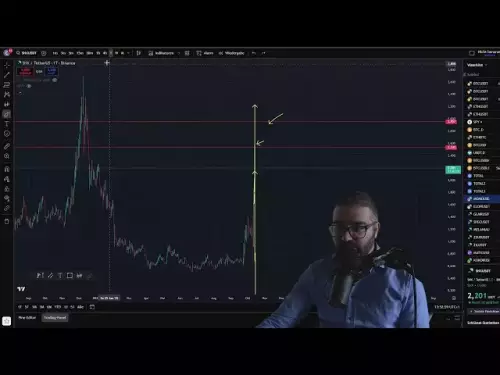-
 bitcoin
bitcoin $115692.075601 USD
5.13% -
 ethereum
ethereum $4162.931611 USD
11.68% -
 bnb
bnb $1310.063287 USD
17.56% -
 tether
tether $1.000983 USD
0.00% -
 xrp
xrp $2.534505 USD
8.16% -
 solana
solana $198.235737 USD
13.49% -
 usd-coin
usd-coin $1.000236 USD
0.02% -
 dogecoin
dogecoin $0.207352 USD
12.89% -
 tron
tron $0.323043 USD
3.62% -
 cardano
cardano $0.701559 USD
11.88% -
 hyperliquid
hyperliquid $39.924597 USD
8.30% -
 chainlink
chainlink $18.934457 USD
11.56% -
 ethena-usde
ethena-usde $1.000552 USD
0.02% -
 stellar
stellar $0.340575 USD
7.05% -
 bitcoin-cash
bitcoin-cash $545.011757 USD
8.86%
How to judge the timing of FORM selling? How to avoid leaving the market too early or too late?
To time FORM selling, analyze market trends, use technical indicators like moving averages and RSI, and consider fundamental factors like project updates and market sentiment.
May 03, 2025 at 08:57 am

How to judge the timing of FORM selling? How to avoid leaving the market too early or too late?
Selling cryptocurrencies, especially a token like FORM, can be a challenging decision that requires careful consideration of various factors. The timing of selling is crucial as it can significantly impact your returns. To effectively judge the right moment to sell FORM and avoid exiting the market either too early or too late, it's essential to understand market trends, technical analysis, and fundamental analysis. This article will delve into these aspects to help you make informed decisions.
Understanding Market Trends
Market trends play a pivotal role in determining when to sell your FORM tokens. These trends are influenced by broader market sentiment, news, and events specific to the cryptocurrency ecosystem.
Bullish Trends: When the market is in a bullish phase, prices tend to rise. If FORM is following this trend, you might consider holding onto your tokens longer to capitalize on potential price increases. However, it's important to monitor for signs of a trend reversal, such as increasing volume on down days or bearish candlestick patterns.
Bearish Trends: Conversely, during bearish trends, prices are falling. In such scenarios, it might be wise to sell FORM before prices drop further. Look for indicators like declining volume on up days or bearish divergence in technical indicators.
Sideways Trends: In a sideways market, prices move within a relatively narrow range. Here, you might consider selling if you believe the range will break downwards or if you need to reallocate your funds to other opportunities.
Technical Analysis for FORM Selling
Technical analysis involves studying historical price data and chart patterns to predict future price movements. It can be a valuable tool for deciding when to sell FORM.
Moving Averages: Simple Moving Averages (SMA) and Exponential Moving Averages (EMA) can help identify trends. If the price of FORM falls below a significant moving average (e.g., 50-day or 200-day), it might signal a good time to sell.
Relative Strength Index (RSI): The RSI measures the speed and change of price movements. An RSI above 70 indicates an overbought condition, suggesting it might be time to sell, while an RSI below 30 indicates an oversold condition, which might warrant holding or buying more.
Support and Resistance Levels: These levels can act as psychological barriers for price movements. If FORM breaks below a key support level, it could be a signal to sell. Conversely, if it struggles to break above a resistance level, you might want to consider selling before a potential price drop.
Candlestick Patterns: Patterns like the bearish engulfing or shooting star can indicate potential reversals. If you spot these patterns on FORM's chart, it might be a good time to sell.
Fundamental Analysis of FORM
Fundamental analysis involves evaluating the underlying factors that can influence the value of FORM. This includes the project's development progress, partnerships, and overall market conditions.
Project Updates: Regularly check for updates from the FORM team. Positive developments, such as new partnerships or successful product launches, can boost the token's value. Conversely, delays or negative news can signal a good time to sell.
Market Sentiment: Use tools like social media sentiment analysis to gauge the overall sentiment towards FORM. A shift from positive to negative sentiment can be a warning sign to sell.
Economic Indicators: Broader economic indicators, such as inflation rates or regulatory news, can impact the entire cryptocurrency market. Keep an eye on these factors as they can influence FORM's price.
Avoiding Selling Too Early
Selling too early can mean missing out on potential gains. To avoid this, consider the following strategies:
Set Clear Profit Targets: Before selling, decide on a target price at which you would be satisfied with your returns. This can help you avoid selling too early out of fear or impatience.
Use Trailing Stop Orders: A trailing stop order allows you to set a stop-loss that moves with the price. This can help you lock in gains while allowing the price to continue rising.
Diversify Your Portfolio: If you're concerned about selling too early, consider diversifying your investments. This way, you can hold onto FORM while also exploring other opportunities.
Avoiding Selling Too Late
Selling too late can result in significant losses. Here are some strategies to help you avoid this pitfall:
Monitor Price Action Closely: Keep a close eye on FORM's price movements. If you notice a sustained downward trend, it might be time to sell.
Set Stop-Loss Orders: A stop-loss order can automatically sell your FORM if the price drops to a certain level. This can help limit your losses.
Stay Informed: Regularly check news and updates related to FORM. If there's negative news that could impact the token's value, consider selling before the price drops further.
Combining Strategies for Optimal Timing
To achieve the best timing for selling FORM, consider combining the insights from market trends, technical analysis, and fundamental analysis. Here's how you can integrate these strategies:
Regularly Review Your Analysis: Continuously monitor market trends, technical indicators, and fundamental factors. Adjust your selling strategy based on the latest information.
Use a Combination of Indicators: Don't rely on a single indicator or analysis method. Use a combination of moving averages, RSI, support and resistance levels, and fundamental updates to make a more informed decision.
Practice Patience and Discipline: Avoid making impulsive decisions based on short-term price fluctuations. Stick to your analysis and sell when the data supports it.
Frequently Asked Questions
Q: How can I stay updated on FORM's fundamental developments?A: To stay updated on FORM's fundamental developments, regularly visit the project's official website and social media channels. Join relevant cryptocurrency forums and subscribe to newsletters from reputable crypto news sources. Additionally, consider setting up alerts for specific keywords related to FORM to receive real-time updates.
Q: What are some common mistakes to avoid when selling FORM?A: Common mistakes include selling based on emotions rather than data, ignoring broader market trends, and not setting clear profit targets or stop-loss levels. Additionally, avoid over-relying on a single analysis method and failing to diversify your portfolio.
Q: Can I use automated trading bots to help with selling FORM?A: Yes, automated trading bots can be used to execute sell orders based on predefined criteria. These bots can help you sell FORM at optimal times by monitoring market conditions and executing trades automatically. However, it's crucial to thoroughly research and test any bot before using it with real funds.
Q: How important is it to consider the overall cryptocurrency market when selling FORM?A: It's very important to consider the overall cryptocurrency market when deciding to sell FORM. The broader market's performance can significantly impact FORM's price. For instance, if the entire market is experiencing a downturn, it might be wise to sell FORM before the price drops further. Conversely, if the market is bullish, holding onto FORM might yield better returns.
Disclaimer:info@kdj.com
The information provided is not trading advice. kdj.com does not assume any responsibility for any investments made based on the information provided in this article. Cryptocurrencies are highly volatile and it is highly recommended that you invest with caution after thorough research!
If you believe that the content used on this website infringes your copyright, please contact us immediately (info@kdj.com) and we will delete it promptly.
- XRP Price Prediction: Weekend Rollercoaster or Rally?
- 2025-10-12 08:45:16
- Bittensor (TAO): Super Bullish Signals Point to Potential 2x Rally
- 2025-10-11 10:25:12
- Silver Price Correction: Navigating the Dip & Identifying Key SEO Keywords
- 2025-10-11 10:25:12
- Decoding Crypto Trends: Bittensor's Bull Run, Cardano's Dip, and LivLive's Presale Buzz in 'Uptober 2025'
- 2025-10-12 08:45:16
- MoonBull: The Crypto Meme Coin Promising 1000x Gains?
- 2025-10-11 10:30:01
- Crypto Payroll Revolution: Stablecoins, Altcoins, and the Future of Salary Payments
- 2025-10-11 10:30:01
Related knowledge

Practical parameter settings for a Bitcoin multi-timeframe moving average system
Sep 18,2025 at 10:54pm
Optimizing Timeframe Combinations for Bitcoin Trading1. Selecting appropriate timeframes is crucial when building a multi-timeframe moving average sys...

How can I filter out false breakouts in Dogecoin high-frequency trading?
Sep 22,2025 at 01:00am
Understanding False Breakouts in Dogecoin Trading1. A false breakout occurs when Dogecoin's price appears to move beyond a defined support or resistan...

Techniques for identifying tops and bottoms in the Bitcoin on-chain NVT model
Sep 20,2025 at 07:54pm
Understanding the NVT Model in Bitcoin Analysis1. The Network Value to Transactions (NVT) ratio is often described as the 'P/E ratio' of the cryptocur...

What does the surge in open interest in Bitcoincoin futures mean?
Sep 20,2025 at 11:18pm
Understanding the Surge in Dogecoin Futures Open Interest1. A surge in open interest within Dogecoin futures indicates a growing number of active cont...

How can I use the Ethereum USDT premium to gauge market sentiment?
Sep 18,2025 at 11:55pm
Understanding the Ethereum USDT Premium1. The Ethereum USDT premium refers to the price difference between USDT (Tether) traded on Ethereum-based plat...

What should I do if Ethereum staking yields decline?
Sep 20,2025 at 06:18am
Understanding the Causes Behind Declining Ethereum Staking Yields1. The Ethereum network transitioned to a proof-of-stake consensus mechanism with the...

Practical parameter settings for a Bitcoin multi-timeframe moving average system
Sep 18,2025 at 10:54pm
Optimizing Timeframe Combinations for Bitcoin Trading1. Selecting appropriate timeframes is crucial when building a multi-timeframe moving average sys...

How can I filter out false breakouts in Dogecoin high-frequency trading?
Sep 22,2025 at 01:00am
Understanding False Breakouts in Dogecoin Trading1. A false breakout occurs when Dogecoin's price appears to move beyond a defined support or resistan...

Techniques for identifying tops and bottoms in the Bitcoin on-chain NVT model
Sep 20,2025 at 07:54pm
Understanding the NVT Model in Bitcoin Analysis1. The Network Value to Transactions (NVT) ratio is often described as the 'P/E ratio' of the cryptocur...

What does the surge in open interest in Bitcoincoin futures mean?
Sep 20,2025 at 11:18pm
Understanding the Surge in Dogecoin Futures Open Interest1. A surge in open interest within Dogecoin futures indicates a growing number of active cont...

How can I use the Ethereum USDT premium to gauge market sentiment?
Sep 18,2025 at 11:55pm
Understanding the Ethereum USDT Premium1. The Ethereum USDT premium refers to the price difference between USDT (Tether) traded on Ethereum-based plat...

What should I do if Ethereum staking yields decline?
Sep 20,2025 at 06:18am
Understanding the Causes Behind Declining Ethereum Staking Yields1. The Ethereum network transitioned to a proof-of-stake consensus mechanism with the...
See all articles










































































